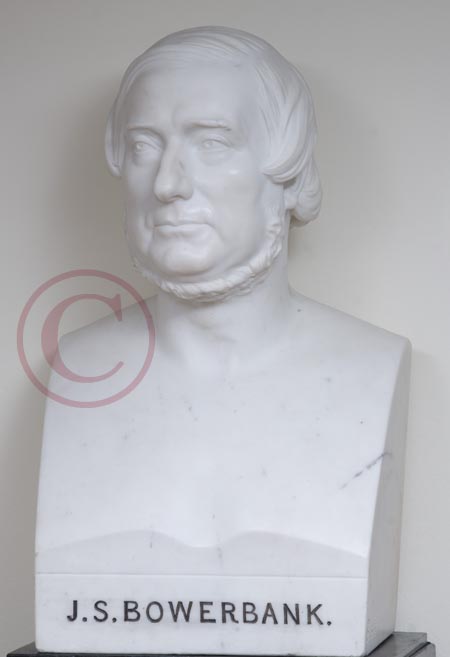Bust of James Scott Bowerbank (1797-1877)
 |
|
Marble bust portrait of James Scott Bowerbank, by Peter Sclater, 1865. (GSL/POR/20). Exhibited at the Royal Academy in 1866. Photograph by Alistair Fyfe, 2009.
Provenance: Presented to the Society by the Committee of the Bowerbank Testimonial Fund Committee, 1866.
|
Elected a Fellow of the Society on 14 March 1832 (no.908). Served on the Society’s Council between 1846-1850 and 1852-1855.
James Scott Bowerbank was born in Bishopsgate, London. Although engaged with running his family’s distillery company, Bowerbank & Co, he still had time for scientific research and in his early years astronomy and natural history, especially botany, engaged much of his attention. Bowerbank became an enthusiastic worker at the microscope, studying the structure of shells, corals, moss agates and flints. He also formed an extensive geological and natural history collection (around 100,000 specimens) and would hold an ‘open house’ on Monday evenings at his house in Park Street, Islington and later Highbury Grove, for those who wished to visit his museum and microscopes.

|
| Cartoon, ‘Highbury Grove in 1846’, satirising Bowerbank's 'open house' at 3 Highbury Grove, Islington. Archive ref: (LDGSL/910) |
In 1840 Bowerbank published the first, and only part, of the monograph ‘A History of the Fossil Fruits and Seeds of the London Clay’, which remained the standard work on the subject for many years.
He initiated or jointly founded a number of other scientific societies, namely: ‘The London Clay Club’ (1836); the Microscopical Society (1839); the Palaeontographical Society (1847); and the Ray Society (1844).